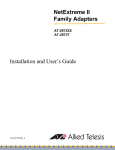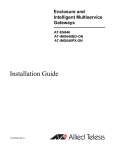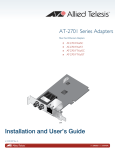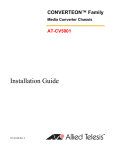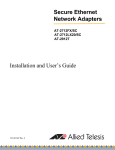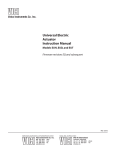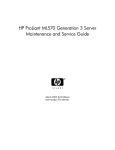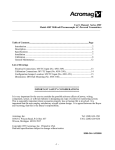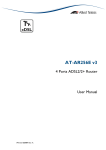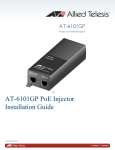Download AT-2812FX Installation and User's Guide
Transcript
ExpressCard Fast Ethernet Fiber (SC) Module AT-2812FX Installation and User’s Guide 613-001225 Rev. A Copyright 2010 Allied Telesis, Inc. All rights reserved. No part of this publication may be reproduced without prior written permission from Allied Telesis, Inc. Microsoft and Internet Explorer are registered trademarks of Microsoft Corporation. Netscape Navigator is a registered trademark of Netscape Communications Corporation. All other product names, company names, logos or other designations mentioned herein are trademarks or registered trademarks of their respective owners. Allied Telesis, Inc. reserves the right to make changes in specifications and other information contained in this document without prior written notice. The information provided herein is subject to change without notice. In no event shall Allied Telesis, Inc. be liable for any incidental, special, indirect, or consequential damages whatsoever, including but not limited to lost profits, arising out of or related to this manual or the information contained herein, even if Allied Telesis, Inc. has been advised of, known, or should have known, the possibility of such damages. Electrical Safety and Emissions Standards This product meets the following standards. U.S. Federal Communications Commission Declaration of Conformity Manufacturer Name: Allied Telesis, Inc. Declares that the product: ExpressCard Fast Ethernet Fiber (SC) Module Model Numbers: AT-2812FX This product complies with FCC Part 15B, Class B Limits: This device complies with part 15 of the FCC Rules. Operation is subject to the following two conditions: (1) This device must not cause harmful interference, and (2) this device must accept any interference received, including interference that may cause undesired operation. Radiated Energy Note: This equipment has been tested and found to comply with the limits for a Class B digital device pursuant to Part 15 of FCC Rules. These limits are designed to provide reasonable protection against harmful interference in a residential installation. This equipment generates, uses and can radiate radio frequency energy and, if not installed and used in accordance with instructions, may cause harmful interference to radio or television reception, which can be determined by turning the equipment off and on. The user is encouraged to try to correct the interference by one or more of the following measures: - Reorient or relocate the receiving antenna. - Increase the separation between the equipment and the receiver. - Connect the equipment into an outlet on a circuit different from that to which the receiver is connected. - Consult the dealer or an experienced radio/TV technician for help. Changes and modifications not expressly approved by the manufacturer or registrant of this equipment can void your authority to operate this equipment under Federal Communications Commission rules. Industry Canada This Class B digital apparatus complies with Canadian ICES-003. Cet appareil numérique de la classe B est conforme à la norme NMB-003 du Canada. European Union Restriction of the Use of Certain Hazardous Substances (RoHS) in Electrical and Electronic Equipment This Allied Telesis RoHS-compliant product conforms to the European Union Restriction of the Use of Certain Hazardous Substances (RoHS) in Electrical and Electronic Equipment. Allied Telesis ensures RoHS conformance by requiring supplier Declarations of Conformity, monitoring incoming materials, and maintaining manufacturing process controls. RFI Emissions FCC Class B, EN55022 Class B, VCCI Class B, C-TICK, CE Immunity EN55024 Electrical Safety EN60950 (TUV), UL 60950-1 (CULUS) Laser Safety EN60825 3 Translated Safety Statements Important: The indicates that a translation of the safety statement is available in a PDF document titled “Translated Safety Statements” posted on the Allied Telesis website at: www.alliedtelesis.com/support/software/. 4 Contents Preface ................................................................................................................................................................................11 Safety Symbols Used in this Document................................................................................................................................12 Where to Find Web-based Guides .......................................................................................................................................13 Contacting Allied Telesis ......................................................................................................................................................14 Online Support ..............................................................................................................................................................14 Email and Telephone Support .......................................................................................................................................14 Returning Products........................................................................................................................................................14 For Sales or Corporate Information ...............................................................................................................................14 Warranty ........................................................................................................................................................................14 Management Software Updates ....................................................................................................................................14 Chapter 1: Introducing the AT-2812FX Module ...............................................................................................................15 Functional Description ..........................................................................................................................................................16 Contents of Your Shipment ...........................................................................................................................................16 Hardware Features ...............................................................................................................................................................18 Supported Operating Systems .............................................................................................................................................19 Physical Description .............................................................................................................................................................20 Chapter 2: Installing the Hardware ..................................................................................................................................21 Reviewing Safety Precautions ..............................................................................................................................................22 Pre-Installation Checklist ......................................................................................................................................................24 Installing the Module.............................................................................................................................................................25 Connecting the Network Cables ...........................................................................................................................................29 Chapter 3: Installing the Vista Driver Software ...............................................................................................................31 Installing the Driver Software................................................................................................................................................32 Installing the Software Drivers for the Windows Vista Operating System .....................................................................32 Selecting the Device Manager ......................................................................................................................................39 Uninstalling the Driver Software ...........................................................................................................................................43 Chapter 4: Installing the Windows XP Driver Software ..................................................................................................45 Installing the Driver Software................................................................................................................................................46 Selecting the Device Manager Window.........................................................................................................................47 Updating the Windows XP Driver Software ...................................................................................................................49 Uninstalling the Driver Software ...........................................................................................................................................52 Chapter 5: Installing the Windows 7 Driver Software ....................................................................................................53 Installing the Driver Software................................................................................................................................................54 Selecting the Device Manager Window.........................................................................................................................54 Installing the Windows 7 Driver Software ......................................................................................................................57 Uninstalling the Driver Software ...........................................................................................................................................60 Chapter 6: Setting Advanced Properties .........................................................................................................................61 Opening Advanced Properties..............................................................................................................................................62 Flow Control ..................................................................................................................................................................63 Interrupt Moderation ......................................................................................................................................................65 IPSec Offload ................................................................................................................................................................65 Large Send Offload Property.........................................................................................................................................67 Network Address ...........................................................................................................................................................68 Priority & VLAN .............................................................................................................................................................69 Receive Side Scaling ....................................................................................................................................................70 Speed & Duplex Mode ..................................................................................................................................................70 5 Contents Checksum Offload .........................................................................................................................................................71 VLAN ID.........................................................................................................................................................................72 Wake Up Capabilities ....................................................................................................................................................73 WOL Speed ...................................................................................................................................................................74 Appendix A: Specifications ..............................................................................................................................................75 Physical Specifications .........................................................................................................................................................75 Environmental Specifications................................................................................................................................................75 Power Specifications.............................................................................................................................................................75 Performance Specification ....................................................................................................................................................76 Operating Specifications .......................................................................................................................................................76 Appendix B: Cleaning Fiber Optic Connectors ...............................................................................................................77 Using a Cartridge-Type Cleaner ...........................................................................................................................................78 Using a Swab........................................................................................................................................................................80 6 Figures Figure 1. AT-2812FX Module ..............................................................................................................................................16 Figure 2. AT-2812FX LED ...................................................................................................................................................20 Figure 3. Selecting the PCI ExpressCard Slot.....................................................................................................................26 Figure 4. Pressing the Button ..............................................................................................................................................26 Figure 5. Removing the Faceplate from the PCI ExpressCard Slot ....................................................................................27 Figure 6. Removing the Plate ..............................................................................................................................................27 Figure 7. Inserting the Module .............................................................................................................................................28 Figure 8. Found New Hardware Window.............................................................................................................................33 Figure 9. Found New Hardware - Ethernet Controller Window ...........................................................................................34 Figure 10. Found New Hardware - Ethernet Controller Window .........................................................................................35 Figure 11. Found New Hardware - Ethernet Controller Windows Couldn’t Find Driver Window .........................................36 Figure 12. Found New Hardware - Ethernet Controller Browse for Driver Software Window .............................................37 Figure 13. Update Driver Software - Allied Telesis AT-2812FX 100FX Fiber Window........................................................38 Figure 14. Control Panel Window ........................................................................................................................................39 Figure 15. Administrative Tools Window .............................................................................................................................40 Figure 16. Computer Management Window ........................................................................................................................41 Figure 17. Device Manager Window....................................................................................................................................42 Figure 18. System Properties Dialog Box............................................................................................................................47 Figure 19. Hardware Tab.....................................................................................................................................................48 Figure 20. Device Manager Window....................................................................................................................................49 Figure 21. Welcome to Hardware Update Wizard Window .................................................................................................50 Figure 22. Hardware Update Wizard Window .....................................................................................................................50 Figure 23. Windows 7 Start Menu .......................................................................................................................................54 Figure 24. Computer Window ..............................................................................................................................................55 Figure 25. Control Panel > System and Security > System Window...................................................................................56 Figure 26. Device Manager Window....................................................................................................................................57 Figure 27. Device Manager Window: Ethernet Controller ...................................................................................................58 Figure 28. Update Driver Software - Ethernet Controller Window .......................................................................................58 Figure 29. Update Driver Software - Ethernet Controller Window: Browse for driver software ...........................................59 Figure 30. Update Driver Software - Confirmation Window.................................................................................................59 Figure 31. Allied Telesis AT-2812FX 100 Mb Fiber Ethernet Properties Window ...............................................................64 Figure 32. Ferrule in an SC Connector Plug........................................................................................................................77 Figure 33. Unclean and Clean Ferrule.................................................................................................................................77 Figure 34. Cartridge Cleaner ...............................................................................................................................................78 Figure 35. Rubbing the Ferrule Tip on the Cleaning Surface ..............................................................................................78 Figure 36. Lint-Free and Alcohol-Free Swabs .....................................................................................................................80 Figure 37. Cleaning a Recessed Ferrule .............................................................................................................................80 7 Figures 8 Tables Table 1: Safety Symbols ......................................................................................................................................................12 Table 2: Fiber Optic Port 100 LED Status ...........................................................................................................................20 9 Tables 10 Preface This guide contains instructions on how to install the AT-2812FX ExpressCard Fast Ethernet Fiber (SC) Module on a laptop computer. It also describes how to install the driver software on the AT-2812FX module and configure the driver software. The Windows Vista, Windows XP, and Windows 7 Operating Systems driver software is described in this manual. Additional operating systems are available on the Allied Telesis website on the software and document download site for this adapter. The Preface contains the following sections: “Safety Symbols Used in this Document” on page 12 “Where to Find Web-based Guides” on page 13 “Contacting Allied Telesis” on page 14 “Management Software Updates” on page 14 11 Preface Safety Symbols Used in this Document This document uses the safety symbols defined in Table 1. Table 1. Safety Symbols Symbol 12 Meaning Description Caution Performing or omitting a specific action may result in equipment damage or loss of data. Warning Performing or omitting a specific action may result in electrical shock. AT-2812FX ExpressCard Fast Ethernet Fiber (SC) Module Installation and User’s Guide Where to Find Web-based Guides The installation and user guides for all Allied Telesis products are available in portable document format (PDF) on our web site at www.alliedtelesis.com/support/software/. You can view the documents online or download them onto a local workstation or server. 13 Preface Contacting Allied Telesis This section provides Allied Telesis contact information for technical support as well as sales or corporate information. Online Support You can request technical support online by accessing the Allied Telesis Knowledge Base: www.alliedtelesis.com/support/kb.aspx. You can use the Knowledge Base to submit questions to our technical support staff and review answers to previously asked questions. Email and Telephone Support For Technical Support via email or telephone, refer to the Support section of the Allied Telesis web site: www.alliedtelesis.com/support. Returning Products Products for return or repair must first be assigned a return materials authorization (RMA) number. A product sent to Allied Telesis without an RMA number will be returned to the sender at the sender’s expense. For instructions on how to obtain an RMA number, go to the Support section on our web site at www.alliedtelesis.com/support/rma.aspx. For Sales or Corporate Information You can contact Allied Telesis for sales or corporate information through our web site at http://www.alliedtelesis.com/purchase. Warranty Management Software Updates Go to www.alliedtelesis.com/warranty for the specific terms and conditions of the warranty and for warranty registration for the AT-2812FX module. New releases of management software for our managed products are available from either of the following Internet sites: Allied Telesis web site: www.alliedtelesis.com/support/software/ Allied Telesis FTP server: ftp://ftp.alliedtelesis.com If you prefer to download new software from the Allied Telesis FTP server from your workstation’s command prompt, you will need FTP client software and you must log in to the server. Enter “anonymous” for the user name and your email address for the password. 14 Chapter 1 Introducing the AT-2812FX Module This chapter provides an introduction to the Allied Telesis AT-2812FX ExpressCard Fast Ethernet Fiber (SC) Module and contains the following sections: “Functional Description” on page 16 “Hardware Features” on page 18 “Supported Operating Systems” on page 19 “Physical Description” on page 20 15 Chapter 1: Introducing the AT-2812FX Module Functional Description The AT-2812FX is a highly integrated Fiber Fast Ethernet ExpressCard/34 module based on Broadcom’s BCM5761S chipset. It provides an PCI ExpressCard interface with SC connections to multimode fiber. Using fiber optic cabling and a connector that meets 62.5/125 µm or 50/ 125 µm multimode specifications, the AT-2812FX module connects a laptop computer to a Fast Ethernet network. This module operates at speeds of 100 Mbps in both full-duplex and half-duplex modes. PCI ExpressCard is the new notebook interface that replaces the PCMCIA Card Bus interface. The PCI ExpressCard interface is available in 34 mm and 54 mm interface-slot sizes. You can install the AT-2812FX module in either slot. LI N K/ AC T The AT-2812FX module has an SC connector, as show in Figure 1. 1757 1756 Figure 1. AT-2812FX Module Contents of Your Shipment 16 The following items are included with your module: Antistatic bag (used for protecting the module when stored or shipped). Keep the module in its packaging until ready for installation. Plastic enclosure (attached to the module) AT-2812FX ExpressCard Fast Ethernet Fiber (SC) Module Installation and User’s Guide Note The AT-2812FX module is not shipped with a software driver CD. To download new driver software for the AT-2812FX module, see “Management Software Updates” on page 14. Inform your network supplier of any missing or damaged items. If you need to return the module, you must pack it in the original (or equivalent) packing material or the warranty will be voided. See “Returning Products” on page 14. The documentation for this module is available in Portable Document Format (PDF) on our web site at www.alliedtelesis.com/support/ software/. You can view the documents online or download them onto a local workstation or server. 17 Chapter 1: Introducing the AT-2812FX Module Hardware Features The following list of hardware features for the AT-2812FX module applies to all of the supported operating systems: 18 One 100BASE-FX port with SC multi-mode fiber connector Full and half duplex Media Access Control (MAC) IPv4 and IPv6 Large Send Offload and Checksum Offload (LSO/TCO) Receive Side Scaling (RSS) for multi-core client processors PCI-ExpressCard Interface Wake on LAN (WOL) support that meets the APCI requirements Statistics for SNMP MIB II, Ethernet-like MIB, and Ethernet MIB (80-2.3z Clause 30) Desktop and mobile Architecture for System Hardware (DASH) v1.1 NDIS 6.0 IPSec task offload v2 (Windows 7 and Vista) Flow Control (IEEE 802.3x) VLAN Tag support (802.1Q) Ethernet Priority (802.1P) Pre-boot Execution Environment (PXE) v2.1 Jumbo Packet Support 48 KB Receive Buffer 8 KB Transmit Buffer Link/Activity LED AT-2812FX ExpressCard Fast Ethernet Fiber (SC) Module Installation and User’s Guide Supported Operating Systems The following operating systems are described in this manual: Windows Vista Windows XP Windows 7 Additional operating systems are available on the following Allied Telesis website: www.alliedtelesis.com/support/software/. 19 Chapter 1: Introducing the AT-2812FX Module Physical Description This section provides descriptions of the AT-2812FX faceplate and the LED. The faceplate on the AT-2812FX module has one fiber port that provides two fiber optic connectors for attaching the module to a compatible link partner (one transmitting and one receiving). LI N K/ AC T The AT-2812FX module has one LED, as shown in Figure 2. See Table 1 for a description of the LED operating status. 1757 Figure 2. AT-2812FX LED Table 1. Fiber Optic Port 100 LED Status State 20 Description Green The port is operating at 100 Mbps and has a valid link. Flashing The port is receiving or transmitting network packets at 100 Mbps. Chapter 2 Installing the Hardware This chapter contains the following sections: “Reviewing Safety Precautions” on page 22 “Pre-Installation Checklist” on page 24 “Installing the Module” on page 25 “Connecting the Network Cables” on page 29 21 Chapter 2: Installing the Hardware Reviewing Safety Precautions Please review the following safety precautions before you begin to install a module. Note The indicates that a translation of the safety statement is available in a PDF document titled “Translated Safety Statements” posted on the Allied Telesis website at www.alliedtelesis.com/ support/software/. Warning This is a “Class 1 LED product”. L1 Warning Do not stare into the laser beam. L2 Warning Do not look directly at the fiber optic cable ends or inspect the cable ends with an optical lens. E29 Warning Do not work on this equipment or cables during periods of lightning activity. E2 Warning Operating Temperature: This product is designed for a maximum ambient temperature of 40 degrees C. E7 Note All Countries: Install this product in accordance with local and National Electric Codes. E8 22 AT-2812FX ExpressCard Fast Ethernet Fiber (SC) Module Installation and User’s Guide Warning The module is being installed in a system that operates with voltages that can be lethal. Before you remove the cover of your system, you must observe the following precautions to protect yourself and to prevent damage to the system components. - Remove any metallic objects or jewelry from your hands and wrists. - Make sure to use only insulated or nonconducting tools. - Verify that the system is powered OFF and unplugged before accessing internal components. - Installation or removal of modules must be performed in a staticfree environment. The use of a properly grounded wrist strap or other personal antistatic devices and an antistatic mat is strongly recommended. 23 Chapter 2: Installing the Hardware Pre-Installation Checklist Before you install the module, check the following list: 1. Verify that your laptop is using the latest BIOS. If you downloaded the module software from the Allied Telesis support website, record the path to where the module driver files reside on your system. 2. If your laptop is active, shut it down. 3. When the system shut down is complete, power OFF and unplug your system. 4. Holding the module by the edges, remove it from its shipping package and place it on an antistatic surface. 5. Check the module for visible signs of damage, particularly on the edge connector. Caution Do not attempt to install a damaged module. If the module is damaged, report it to Allied Telesis. See “Contacting Allied Telesis” on page 14. 24 AT-2812FX ExpressCard Fast Ethernet Fiber (SC) Module Installation and User’s Guide Installing the Module The following instructions describe how to install the AT-2812FX module in a laptop equipped with a PCI ExpressCard interface slot. This procedure applies to laptops with either 34 mm or 54 mm interface slots. For laptop computers, the 54 mm interface is the more common interface. Therefore, the installation illustrations in this manual use the 54 mm interface. For additional details about performing these tasks on your particular PC, refer to the manual that was supplied with your laptop. Note Allied Telesis recommends that you turn off your PC before installing the AT-2812FX module. Note To perform this procedure, you need to supply a pen. To install an AT-2812FX module, perform the following procedure: 1. Review the “Pre-Installation Checklist” on page 24 and “Reviewing Safety Precautions” on page 22. Before installing the module, ensure the laptop power is OFF and unplugged from the power outlet. 2. Select the 34 mm or 54 mm ExpressCard slot. See Figure 3 on page 26 for an example of the 54 mm ExpressCard slot. Note If you do not know how to identify a PCI ExpressCard slot, refer to your laptop documentation. 25 Chapter 2: Installing the Hardware 1758 Figure 3. Selecting the PCI ExpressCard Slot 3. Use a pen and press the button toward the laptop and to the left. See Figure 4. The button pops out along with the plate. See Figure 5 on page 27. 1710 Figure 4. Pressing the Button 26 AT-2812FX ExpressCard Fast Ethernet Fiber (SC) Module Installation and User’s Guide 1711 Figure 5. Removing the Faceplate from the PCI ExpressCard Slot 4. Remove the plate from the laptop. See Figure 6. Keep the plate in a safe place. You may need it for future use. 1712 Figure 6. Removing the Plate 27 Chapter 2: Installing the Hardware 5. For the 54 mm ExpressCard slot, align the module to the left side of the slot. See Figure 7. LI N K/ AC T For laptops with the 34 mm ExpressCard slot, the module fits snugly into the slot. 1713 Figure 7. Inserting the Module 6. Applying even pressure at both corners of the module, push the module until it is firmly seated in the PCI ExpressCard slot. Caution Do not use excessive force when seating the module, because this may damage the system or the module. If the module resists seating, remove it from the system, realign it, and try again. 7. Make sure the module is seated securely. 8. Power the system on. Once the system returns to proper operation, the module hardware is fully installed. Next, connect the network cables. See “Connecting the Network Cables” on page 29. 28 AT-2812FX ExpressCard Fast Ethernet Fiber (SC) Module Installation and User’s Guide Connecting the Network Cables The AT-2812FX module has two fiber optic connectors (transmit and receive) for attaching the system to a compatible link partner, or an IEEE 802.3z compliant Fast Ethernet switch. The module requires a fiber optic cable. For specifications for this cable, see the AT-2812FX module data sheet or Appendix A, “Specifications” on page 75. After you install the cables, see the appropriate chapter for software driver installation and configuration information. See one of the following chapters: Chapter 3, “Installing the Vista Driver Software” on page 31 Chapter 4, “Installing the Windows XP Driver Software” on page 45 Chapter 5, “Installing the Windows 7 Driver Software” on page 53 To connect a network cable to the module, do the following: Warning The fiber optic ports contain a Class 1 LED device. When the ports are disconnected, always cover them with the provided plug. Exposed ports may cause skin or eye damage. 1. Connect one end of the cable to the module. 2. Connect the other end of the cable to the appropriate Ethernet fiber optic port. After you connect the system to the network and power is supplied, the AT-2812FX module attempts to establish the connection at 100 Mbps full-duplex mode by default. See “Speed & Duplex Mode” on page 70 for instructions to change the connection to half duplex mode. Note After the cable is properly connected at both ends, the module port LED is functional. See “Physical Description” on page 20 for a description of the LED operation. Note For instructions that describe how to clean the fiber optic connector, see Appendix B “Cleaning Fiber Optic Connectors” on page 77 29 Chapter 2: Installing the Hardware 30 Chapter 3 Installing the Vista Driver Software This chapter describes how to install and update the Vista driver software for the AT-2812FX module. The installation procedure is identical for the both the Vista 32-bit and 64-bit operating systems. This chapter contains the following sections: “Installing the Driver Software” on page 32 “Uninstalling the Driver Software” on page 43 Note To set Advanced Properties, see Chapter 6, “Setting Advanced Properties” on page 61. 31 Chapter 3: Installing the Vista Driver Software Installing the Driver Software After you install an Allied Telesis AT-2812FX module in your laptop computer, the system detects the new hardware automatically when the Windows Vista Operating system first boots up. Shortly after you log in, you are prompted to install the driver software for the module. To install or update the driver software, you must have administrative privileges. This section provides the following procedures: Installing the Software Drivers for the Windows Vista Operating System “Installing the Software Drivers for the Windows Vista Operating System” on page 32 “Selecting the Device Manager” on page 39 To install the AT-2812FX driver software for the Vista Operating System, do the following: Note The module must be physically installed in your system before you can install the driver software. See Chapter 2, “Installing the Hardware” on page 21 for instructions. 1. Start a Windows Vista Operating system and log in. You must have Administrator privileges to install or update the driver software. 2. The Found New Hardware window is displayed on your personal computer. The Found New Hardware window is shown in Figure 8 on page 33. 32 AT-2812FX ExpressCard Fast Ethernet Fiber (SC) Module Installation and User’s Guide Figure 8. Found New Hardware Window 3. From the Found New Hardware window, select Locate and install driver software (recommended). The Found New Hardware - Ethernet Controller window is displayed. See Figure 9 on page 34. 33 Chapter 3: Installing the Vista Driver Software Figure 9. Found New Hardware - Ethernet Controller Window 4. From the Found New Hardware - Ethernet Controller window, select Don’t search online. The Found New Hardware - Ethernet Controller window is displayed. See Figure 10 on page 35. 34 AT-2812FX ExpressCard Fast Ethernet Fiber (SC) Module Installation and User’s Guide Figure 10. Found New Hardware - Ethernet Controller Window 5. Click I don’t have the disc. Show me other options. Note The AT-2812FX module is not shipped with a CD. The Found New Hardware - Ethernet Controller Windows Couldn’t Find Driver window is displayed. See Figure 11 on page 36. 35 Chapter 3: Installing the Vista Driver Software Figure 11. Found New Hardware - Ethernet Controller Windows Couldn’t Find Driver Window 6. Select Browse my computer for drive software (advanced). Select the directory where the AT-2812FX driver is located. You recorded this location during the pre-installation checklist. See “PreInstallation Checklist” on page 24. 36 AT-2812FX ExpressCard Fast Ethernet Fiber (SC) Module Installation and User’s Guide The following window is displayed: Figure 12. Found New Hardware - Ethernet Controller Browse for Driver Software Window Then a confirmation page is displayed. See Figure 13 on page 38. 37 Chapter 3: Installing the Vista Driver Software Figure 13. Update Driver Software - Allied Telesis AT-2812FX 100FX Fiber Window 7. Confirm that the AT-2812FX module has been installed successfully by opening the Device Manager. To open the Device Manager, see “Selecting the Device Manager” on page 39. 38 AT-2812FX ExpressCard Fast Ethernet Fiber (SC) Module Installation and User’s Guide Selecting the Device Manager To select the Device Manager in the Windows Vista Operating System, do the following: 1. From the Start menu, select Settings and then the Control Panel. See Figure 14. Figure 14. Control Panel Window 39 Chapter 3: Installing the Vista Driver Software 2. From the Control Panel, select Administrative Tools. The Administrative Tools window is displayed. See Figure 15. Figure 15. Administrative Tools Window 3. From the Administrative Tools window, select Computer Management (local). The Computer Management window is displayed. See Figure 16 on page 41. 40 AT-2812FX ExpressCard Fast Ethernet Fiber (SC) Module Installation and User’s Guide Figure 16. Computer Management Window 4. From the Computer Management Window, select Device Manager in the left panel. The Device Manager window is displayed. See Figure 17 on page 42. 41 Chapter 3: Installing the Vista Driver Software On the Device Manager window, “Allied Telesis AT-2812FX Fiber” is listed under “Network adapters.” Figure 17. Device Manager Window 42 AT-2812FX ExpressCard Fast Ethernet Fiber (SC) Module Installation and User’s Guide Uninstalling the Driver Software The procedure in this section describes how to uninstall the driver software. Note You must have Administrator privileges to remove the driver software. Caution Before uninstalling the Allied Telesis device, capture all of the Advanced Property settings because the properties are lost during the uninstall process. To uninstall the driver software from your system, do the following: 1. Start Windows Vista and log in. 2. Open the Device Manager. For instructions on how to open the Device Manager, see “Selecting the Device Manager” on page 39. The Device Manager Window is shown in Figure 17 on page 42. 3. In the Device Manager window, click the + next to the Network Adapters folder. The selection expands to show the list of installed network adapter cards. 4. Right-click on the module you want to remove and select Uninstall. A Confirm Device Removal window opens. 5. Click OK to complete the uninstall. Note Not all of the driver files are removed as a result of this procedure. You can remove additional drivers and installation files by selecting the checkbox to remove these files. 43 Chapter 3: Installing the Vista Driver Software 44 Chapter 4 Installing the Windows XP Driver Software This chapter describes how to install the Windows XP driver software on the AT-2812FX module. This chapter covers the following topics: “Installing the Driver Software” on page 46 “Uninstalling the Driver Software” on page 52 Note To set Advanced Properties, see Chapter 6, “Setting Advanced Properties” on page 61. 45 Chapter 4: Installing the Windows XP Driver Software Installing the Driver Software After you install an Allied Telesis AT-2812FX module in your laptop, the system detects the new hardware and creates an entry in the Device Manager when the Windows XP Operating system first boots up. Shortly after you log in, you need to install the driver software for the AT-2812FX module. To install or update the driver software, you must have administrative privileges. To download new driver software for the AT-2812FX module, see “Management Software Updates” on page 14. Note The adapter must be physically installed in your system before installing the driver software. See Chapter 2, “Installing the Hardware” on page 21 for details. Note If the Windows XP system detects an adapter and installs a default driver, update the driver as described in “Updating the Windows XP Driver Software” on page 49. Note If there is an onboard Broadcom network interface, the native Broadcom driver may load. Update the drive, as described in “Updating the Windows XP Driver Software” on page 49. This section provides the following procedures: “Selecting the Device Manager Window” on page 47 “Updating the Windows XP Driver Software” on page 49 When you update the driver software on an existing module, the Advanced Property settings may not be updated unless you remove the existing module by following the instructions in “Uninstalling the Driver Software” on page 52. Then perform a scan for hardware changes in the device manager, followed by reinstalling the device with the current adapter software as described in “Updating the Windows XP Driver Software” on page 49. Note You must have Administrator privileges to update the driver software. 46 AT-2812FX ExpressCard Fast Ethernet Fiber (SC) Module Installation and User’s Guide Selecting the Device Manager Window You use the Device Manager window to both install and uninstall the Windows XP driver software for the AT-2812FX adapter. To open the Device Manager window on a Windows XP Operating System, do the following: 1. Start a Windows XP system and log in. 2. On the desktop, right click My Computer. The My Computer window opens. 3. Select Properties from the menu. The System Properties Dialog Box is displayed as shown in Figure 18. Figure 18. System Properties Dialog Box 4. Select the Hardware Tab. 47 Chapter 4: Installing the Windows XP Driver Software The Hardware Tab is shown in Figure 19. Figure 19. Hardware Tab 5. Click Device Manager. The Device Manager window is shown in Figure 20 on page 49. 48 AT-2812FX ExpressCard Fast Ethernet Fiber (SC) Module Installation and User’s Guide Figure 20. Device Manager Window Updating the Windows XP Driver Software To update the adapter software on a Windows XP Operating System, do the following: 1. Start a Windows XP system and log in. You must have Administrator privileges to update the driver software. 2. Open the Device Manager. For instructions, see “Selecting the Device Manager Window” on page 47. 3. In the Device Manager window, click the + next to the Network Adapters folder. The selection expands to show the list of installed network adapter cards. 4. Right click on the adapter whose driver you want to update and select Update Driver. The Hardware Update Wizard Window opens, as shown in Figure 21. 49 Chapter 4: Installing the Windows XP Driver Software Figure 21. Welcome to Hardware Update Wizard Window 5. Click No, not this time to copy the driver software from your system. You recorded the location of the driver software in the “Pre-Installation Checklist” on page 24. 6. Click Next. The Second New Found Hardware Wizard Window opens, as shown in Figure 22. Figure 22. Hardware Update Wizard Window 50 AT-2812FX ExpressCard Fast Ethernet Fiber (SC) Module Installation and User’s Guide 7. Click Install from a list or specific location (Advanced). 8. Click Next. 9. When you are prompted to specify the location of the drive, click Browse and locate the path of the drivers. Update all adapters by repeating the above steps for each device. After driver software installation is complete, you are ready to modify the configuration properties. See “Uninstalling the Driver Software” on page 52. 51 Chapter 4: Installing the Windows XP Driver Software Uninstalling the Driver Software To uninstall the Windows XP driver software from your laptop, do the following: Note You must have Administrator privileges to remove the driver software. Caution Before uninstalling the Allied Telesis device, be sure to capture all of the Advanced Property settings because the properties are lost during the uninstall process. 1. Start Windows XP and log in. 2. Open the Device Manager. For instructions on how to open the Device Manager window, see “Selecting the Device Manager Window” on page 47. The Device Manager window is shown in Figure 20 on page 49. 3. In the Device Manager window, click the + next to the Network Adapters folder. The folder expands to show the list of installed network adapter cards. 4. Right-click on the adapter you want to remove and select Uninstall. A Confirm Device Removal window opens. 5. Click OK to complete the uninstall. 52 Chapter 5 Installing the Windows 7 Driver Software This chapter describes how to install the Windows 7 driver software on the AT-2812FX module. The installation and configuration procedure are identical for the both the 32-bit and 64-bit Windows 7 Operating Systems. This chapter contains the following sections: “Installing the Driver Software” on page 54 “Uninstalling the Driver Software” on page 60 Note To set Advanced Properties, see Chapter 6, “Setting Advanced Properties” on page 61. 53 Chapter 5: Installing the Windows 7 Driver Software Installing the Driver Software After you install an Allied Telesis AT-2812FX module in your laptop, the system detects the new hardware and creates an entry in the Device Manager when the Windows 7 Operating system first boots up. Shortly after you log in, you need to install the driver software for the AT-2812FX module. To install or update the driver software, you must have administrative privileges. This section provided the following procedures: Selecting the Device Manager Window “Selecting the Device Manager Window” on page 54 “Installing the Windows 7 Driver Software” on page 57 You use the Device Manager window to both install and uninstall the Windows 7 driver software for the AT-2812FX adapter. To open the Device Manager window in the Windows 7 Operating System, do the following: 1. Click on the Start menu. See Figure 23 for an example of the Windows 7 Start menu. Figure 23. Windows 7 Start Menu 54 AT-2812FX ExpressCard Fast Ethernet Fiber (SC) Module Installation and User’s Guide 2. Select Computer on the right side of the menu. The Computer window is displayed. See Figure 24. Figure 24. Computer Window 3. Select System properties at the top of the page. The Control Panel > System and Security > System Window is displayed. See Figure 25 on page 56. 55 Chapter 5: Installing the Windows 7 Driver Software Figure 25. Control Panel > System and Security > System Window 4. Select Device Manager from the bookmarks on the left side of the window to confirm that the AT-2812FX module has been installed successfully. The Device Manager window is displayed. See Figure 26 on page 57. On the Device Manager window, “Allied Telesis AT-2812FX Fiber Ethernet” is listed under “Network adapters.” 56 AT-2812FX ExpressCard Fast Ethernet Fiber (SC) Module Installation and User’s Guide Figure 26. Device Manager Window Installing the Windows 7 Driver Software To install the Windows 7 Operating System driver software, do the following: Note The module must be physically installed in your system before you install the driver software. See Chapter 2, “Installing the Hardware” on page 21 for instructions. 1. Start a Windows 7 Operating system and log in. 2. Open the Device Manager window. For instructions on how to open the Device Manager window, see “Selecting the Device Manager Window” on page 54. 57 Chapter 5: Installing the Windows 7 Driver Software 3. On the Device Manager Window, right click Ethernet Controller and select Update Driver Software. See Figure 27. Figure 27. Device Manager Window: Ethernet Controller The Update Driver Software - Ethernet Controller Window is displayed. See Figure 28. Figure 28. Update Driver Software - Ethernet Controller Window 4. Click Browse my computer for driver software. The Update Driver Software - Ethernet Controller window is displayed. See Figure 29 on page 59. 58 AT-2812FX ExpressCard Fast Ethernet Fiber (SC) Module Installation and User’s Guide 5. Browse your computer for the location of the driver software. See Figure 29. Figure 29. Update Driver Software - Ethernet Controller Window: Browse for driver software 6. Click Browse. A confirmation message is displayed. See Figure 30. Figure 30. Update Driver Software - Confirmation Window 59 Chapter 5: Installing the Windows 7 Driver Software Uninstalling the Driver Software Before physically removing a module from your system, you need to uninstall the driver software first. The procedure in this section describes how to uninstall the driver software. Note You must have Administrator privileges to remove the driver software. Caution Before uninstalling the Allied Telesis device, be sure to capture all of the Advanced Property settings because the properties are lost during the uninstall process. To uninstall the driver software from your system, do the following: 1. Start the Windows 7 Operating System on your laptop and log in. 2. Open the Device Manager. For instructions on how to open the Device Manager window, see “Selecting the Device Manager Window” on page 54. The Device Manager window is shown in Figure 26 on page 57. 3. In the Device Manager window, click the + next to the Network Adapters folder. The selection expands to show the list of installed network adapter cards. 4. Right-click on the module you want to remove and select Uninstall. A Confirm Device Removal window opens. 5. Click OK to complete the uninstall. Note Not all of the driver files are removed as a result of this procedure. You can remove additional drivers and installation files by selecting the checkbox to remove these files. 60 Chapter 6 Setting Advanced Properties For the Windows Vista, Windows XP, and Windows 7 Operating System software, you access the Advanced Properties through the Device Manager. Accessing the Device Manager is slightly different for all 3 operating systems. This chapter contains the following section: “Opening Advanced Properties” on page 62 61 Chapter 6: Setting Advanced Properties Opening Advanced Properties In most cases, the default property values are appropriate although you can change any of the available options to meet the requirements of your system. You must have Administrator privileges to modify the driver software. After the driver software has been installed, you can use the following procedures to verify or change the adapter properties: “Flow Control” on page 63 “Interrupt Moderation” on page 65 “IPSec Offload” on page 65 “Large Send Offload Property” on page 67 “Network Address” on page 68 “Priority & VLAN” on page 69 “Receive Side Scaling” on page 70 “Speed & Duplex Mode” on page 70 “Checksum Offload” on page 71 “VLAN ID” on page 72 “Wake Up Capabilities” on page 73 “WOL Speed” on page 74 Note After you upgrade the driver software, the Advanced Properties may change. Note The procedures in the sections listed above may differ slightly if the “Classic Start Menu” is set on your computer. 62 AT-2812FX ExpressCard Fast Ethernet Fiber (SC) Module Installation and User’s Guide Flow Control The Flow Control property allows you to enable or disable the receipt or transmission of PAUSE frames which enable the adapter and the switch to control the transmit rate. The port side that receives the PAUSE frame momentarily stops transmitting. The recommended selection is Disable, which configures the adapter to ignore PAUSE frames. By default, the Flow Control property is disabled. To change the Flow Control property, do the following: 1. Access the Device Manger for your operating system. To access the Windows XP Device Manager, see “Selecting the Device Manager Window” on page 47. To access the Windows Vista Device Manager, see “Selecting the Device Manager” on page 39. To access the Windows 7 Device Manager, see “Selecting the Device Manager Window” on page 54. 2. Click the Advanced tab. The Advanced tab is shown in Figure 31 on page 64. 3. From the Property list on the Advanced tab, select Flow Control. 4. From the Value list on the Advanced tab, select one of the following: Auto - (default) PAUSE frame receipt and transmission is optimized. Disable - PAUSE frame receipt and transmission is disabled (recommended). Rx PAUSE - PAUSE frame receipt is enabled. Rx/Tx PAUSE - PAUSE frame receipt and transmission is enabled. Tx PAUSE - PAUSE frame transmission is enabled. 5. Click OK. 6. If prompted to restart your computer, click Yes. Although it is not necessary to reboot the system for new adapter properties to take effect, rebooting is recommended to reinitialize all registers. 7. Verify that the port LED operates as described in “Physical Description” on page 20. 63 Chapter 6: Setting Advanced Properties The Advanced tab for the AT-2812FX adapter is shown in Figure 31. Figure 31. Allied Telesis AT-2812FX 100 Mb Fiber Ethernet Properties Window 64 AT-2812FX ExpressCard Fast Ethernet Fiber (SC) Module Installation and User’s Guide Interrupt Moderation Interrupt moderation enables adaptive interrupt coalescing, which limits the rate of interrupt to the CPU during packet transmission and packet reception. The disabled option allows one interrupt for every packet transmission and packet reception. The default value is Enabled. To change the Interrupt Moderation setting, do the following: 1. Access the Device Manger for your operating system. To access the Windows XP Device Manager, see “Selecting the Device Manager Window” on page 47. To access the Windows Vista Device Manager, see “Selecting the Device Manager” on page 39. To access the Windows 7 Device Manager, see “Selecting the Device Manager Window” on page 54. 2. From the Advanced tab under Property, select Interrupt Moderation. For an example of the Advanced tab, see Figure 31 on page 64. 3. From the Value list on the Advanced tab, select one of the following: Enabled Disabled 4. Click OK. 5. If prompted to restart your computer, click Yes. Although it is not necessary to reboot the system for new adapter properties to take effect, rebooting is recommended to reinitialize all registers. 6. Verify that the port LED operates as described in “Physical Description” on page 20. IPSec Offload Traditionally, IPSec has been used for remote connections, but this feature has moved into the Local Area Network (LAN) to secure local network traffic against eavesdropping. Vista’s Next Generation TCP/IP stack provides APIs for accessing brackets to allow advanced granularity to filter both inbound and outbound traffic.This was not possible with Microsoft’s XP Operating system. In addition, Vista’s security management now closely ties the firewall and IPSec features together by using a snap-in called Windows Firewall with Advanced Security. The onboard encryption engine on the AT-2812FX module off-loads this task to the network controller instead of the host CPU, thereby freeing the host CPU for other important tasks. The offloading feature is unique in the industry and enables you to set tight security efficiently within your network at a minimal cost. 65 Chapter 6: Setting Advanced Properties Microsoft’s Technet website, www.technet.microsoft.com, offers several technical publications and online seminars that describe Vista’s advanced IPSec and Firewall features as well as their implementation. These topics are beyond the scope of this chapter. Instead, Allied Telesis recommends that you consult Technet for additional information. By default, the IPSec Offload property is set to Disabled. Note The IPSec Offload feature applies only to Windows Vista and Windows 7. To change the IPSec Offload setting, do the following: 1. Access the Device Manger for your operating system. To access the Windows XP Device Manager, see “Selecting the Device Manager Window” on page 47. To access the Windows Vista Device Manager, see “Selecting the Device Manager” on page 39. To access the Windows 7 Device Manager, see “Selecting the Device Manager Window” on page 54. 2. From the Advanced tab under Property, select IPSec Offload. For an example of the Advanced tab, see Figure 31 on page 64. 3. From the Value list on the Advanced tab, select one of the following: Auth Header & ESP Enabled Auth Header Enabled Disabled ESP Enabled 4. Click OK. 5. If prompted to restart your computer, click Yes. Although it is not necessary to reboot the system for new adapter properties to take effect, rebooting is recommended to reinitialize all registers. 6. Verify that the port LED operates as described in “Physical Description” on page 20. 66 AT-2812FX ExpressCard Fast Ethernet Fiber (SC) Module Installation and User’s Guide Large Send Offload Property Normally, the protocol stack performs TCP segmentation. When you enable the Large Send Offload property, the network adapter does the TCP segmentation. There are several Large Send Offload properties to choose from, depending on the TCP/IP version you are using on your PC. You can select IPV4, IPV4 version 2, or IPv6 version 2. By default, the Large Send Offload Property is disabled. To change the Large Send Offload property, do the following: 1. Access the Device Manger for your operating system. To access the Windows XP Device Manager, see “Selecting the Device Manager Window” on page 47. To access the Windows Vista Device Manager, see “Selecting the Device Manager” on page 39. To access the Windows 7 Device Manager, see “Selecting the Device Manager Window” on page 54. 2. Click the Advanced tab. The Advanced tab is shown in Figure 31 on page 64. 3. From the Property list on the Advanced tab, select one of the following: Large Send Offload (IPv4) Large Send Offload v2 (IPv4) Large Send Offload v2 (IPv6) 4. From the Value list on the Advanced tab, select one of the following: Enable - Enables the Large Send Offload property. Disable - Disables the Large Send Offload property. This is the default. 5. Click OK. 6. If prompted to restart your computer, click Yes. Although it is not necessary to reboot the system for new adapter properties to take effect, rebooting is recommended to reinitialize all registers. 7. Verify that the port LED operates as described in “Physical Description” on page 20. 67 Chapter 6: Setting Advanced Properties Network Address The Network Address is a user-defined address that is used to replace the MAC address that was originally assigned to the adapter. The network address consists of a 12-digit hexadecimal number. To change the Locally Administered Address property, do the following: 1. Access the Device Manger for your operating system. To access the Windows XP Device Manager, see “Selecting the Device Manager Window” on page 47. To access the Windows Vista Device Manager, see “Selecting the Device Manager” on page 39. To access the Windows 7 Device Manager, see “Selecting the Device Manager Window” on page 54. 2. Click the Advanced tab. The Advanced tab is shown in Figure 31 on page 64. 3. From the Property list on the Advanced tab, select Network Address. 4. In the Value list on the Advanced tab, enter the Locally Administered Address. Here are some guidelines: The range is 0000 0000 0001 to FFFF FFFF FFFD. Do not use a multicast address (least significant bit of the high byte = 1). Do not use all 0's or all F's. 5. Click OK. 6. If prompted to restart your computer, click Yes. Although it is not necessary to reboot the system for new adapter properties to take effect, rebooting is recommended to reinitialize all registers. 7. Verify that the port LED operates as described in “Physical Description” on page 20. 68 AT-2812FX ExpressCard Fast Ethernet Fiber (SC) Module Installation and User’s Guide Priority & VLAN Priority allows you to prioritize traffic or limit bandwidth instead of treating all traffic in the same manner. A Virtual Local Area Network (VLAN) is a logical area network that extends beyond a traditional LAN to a group of logical LANs. By default, this property is set to Priority & VLAN Enabled. To set the port priority and assign a VLAN ID, do the following: 1. Access the Device Manger for your operating system. To access the Windows XP Device Manager, see “Selecting the Device Manager Window” on page 47. To access the Windows Vista Device Manager, see “Selecting the Device Manager” on page 39. To access the Windows 7 Device Manager, see “Selecting the Device Manager Window” on page 54. 2. Click the Advanced tab. The Advanced tab is shown in Figure 31 on page 64. 3. From the Property list on the Advanced tab, select “Priority & VLAN.” 4. In the Value list on the Advanced tab, select one of the following: Priority & VLAN Disabled Priority & VLAN Enabled Priority Enabled VLAN Enabled 5. Click OK. 6. If prompted to restart your computer, click Yes. Although it is not necessary to reboot the system for new adapter properties to take effect, rebooting is recommended to reinitialize all registers. 7. Verify that the port LED operates as described in “Physical Description” on page 20. 69 Chapter 6: Setting Advanced Properties Receive Side Scaling The Receive Side Scaling (RSS) feature configures RSS queues from 1 to 4. The available options are RSS 1 Queue, RSS 2 Queue, and RSS 4 Queue. By default, RSS is set to Enabled. To set Receive Side Scaling, do the following: 1. Access the Device Manger for your operating system. To access the Windows XP Device Manager, see “Selecting the Device Manager Window” on page 47. To access the Windows Vista Device Manager, see “Selecting the Device Manager” on page 39. To access the Windows 7 Device Manager, see “Selecting the Device Manager Window” on page 54. 2. Click the Advanced tab. The Advanced tab is shown in Figure 31 on page 64. 3. From the Property list on the Advanced tab, select “Receive Side Scaling.” 4. In the Value list on the Advanced tab, select one of the following: Enabled Disabled 5. Click OK. 6. If prompted to restart your computer, click Yes. Although it is not necessary to reboot the system for new adapter properties to take effect, rebooting is recommended to reinitialize all registers. 7. Verify that the port LED operates as described in “Physical Description” on page 20. Speed & Duplex Mode The speed and duplex mode feature allows you to set the speed of the adapter as well as the change the duplex mode from full to half. By default, the duplex mode is set to a speed of 100 Mb in full duplex mode. To change the speed and duplex mode of an adapter, do the following: 1. Access the Device Manger for your operating system. 70 To access the Windows XP Device Manager, see “Selecting the Device Manager Window” on page 47. To access the Windows Vista Device Manager, see “Selecting the Device Manager” on page 39. AT-2812FX ExpressCard Fast Ethernet Fiber (SC) Module Installation and User’s Guide To access the Windows 7 Device Manager, see “Selecting the Device Manager Window” on page 54. 2. Click the Advanced tab. The Advanced tab is shown in Figure 31 on page 64. 3. From the Property list on the Advanced tab, select “Speed & Duplex.” 4. In the Value list on the Advanced tab, select one of the following: 100 Mb Full 100 Mb Half 5. Click OK. 6. If prompted to restart your computer, click Yes. Although it is not necessary to reboot the system for new adapter properties to take effect, rebooting is recommended to reinitialize all registers. 7. Verify that the port LED operates as described in “Physical Description” on page 20. Checksum Offload Usually, the Checksum Offload function is computed by the protocol stack. By selecting one of the Checksum Offload properties, the adapter can compute the checksum. To change the Checksum Offload setting, do the following: 1. Access the Device Manger for your operating system. To access the Windows XP Device Manager, see “Selecting the Device Manager Window” on page 47. To access the Windows Vista Device Manager, see “Selecting the Device Manager” on page 39. To access the Windows 7 Device Manager, see “Selecting the Device Manager Window” on page 54. 2. Click the Advanced tab. The Advanced tab is shown in Figure 31 on page 64. 3. From the Property list under the Advanced tab, select TCP/UDP Checksum Offload v4, or TCP/UDP Checksum Offload v6. 71 Chapter 6: Setting Advanced Properties 4. From the Value list on the Advanced tab, select one of the following: None - Disables checksum offloading. Rx TCP/IP Checksum - Enables receive TCP, IP, and UDP checksum offloading. Tx TCP/IP Checksum - Enables transmit TCP, IP, and UDP checksum offloading. Tx/Rx TCP/IP Checksum (default) - Enables transmit and receive TCP, IP, and UDP checksum offloading. 5. Click OK. 6. If prompted to restart your computer, click Yes. Although it is not necessary to reboot the system for new adapter properties to take effect, rebooting is recommended to reinitialize all registers. 7. Verify that the port LED operates as described in “Physical Description” on page 20. VLAN ID The VLAN ID specifies the VLAN identifier. It is the number of the VLAN where the port is an untagged member. You must assign a VLAN ID to a VLAN. The range is 1 to 4094. The default VLAN has a VLAN ID of 0. To assign a VLAN ID, do the following: 1. Access the Device Manger for your operating system. To access the Windows XP Device Manager, see “Selecting the Device Manager Window” on page 47. To access the Windows Vista Device Manager, see “Selecting the Device Manager” on page 39. To access the Windows 7 Device Manager, see “Selecting the Device Manager Window” on page 54. 2. Click the Advanced tab. The Advanced tab is shown in Figure 31 on page 64. 3. Under Property list on the Advanced tab, select VLAN ID. 4. From the Value list on the Advanced tab, choose a VLAN ID from 1 to 4094. Note The default VLAN has a VLAN ID of 0. 72 AT-2812FX ExpressCard Fast Ethernet Fiber (SC) Module Installation and User’s Guide 5. Click OK. 6. If prompted to restart your computer, click Yes. Although it is not necessary to reboot the system for new adapter properties to take effect, rebooting is recommended to reinitialize all registers. 7. Verify that the port LED operates as described in “Physical Description” on page 20. Wake Up Capabilities The Wake Up Capabilities property enables the network adapter to wake up from a low-power mode when it receives a network wake-up frame. There are two types of wake-up frames: Magic Packet and Wake Up Frame. The default setting is Both - which implements both the Magic Packet and Wake Up Frame. To change the Wake Up Capabilities property, do the following: 1. Access the Device Manger for your operating system. To access the Windows XP Device Manager, see “Selecting the Device Manager Window” on page 47. To access the Windows Vista Device Manager, see “Selecting the Device Manager” on page 39. To access the Windows 7 Device Manager, see “Selecting the Device Manager Window” on page 54. 2. Click the Advanced tab. The Advanced tab is shown in Figure 31 on page 64. 3. From the Property list on the Advanced tab, select Wake Up Capabilities. 4. From the Value list on the Advanced tab, select one of the following: Both - Implements Magic Packet and Wake Up Frame. Magic Packet - Selects Magic Packet as the Wake Up frame. None - Selects no wake-up frame. Wake Up Frame - Selects Wake Up Frame as the wake-up frame and allows the network adapter to wake up the system when an event, such as a ping or an ARP request, is received. 5. Click OK. 73 Chapter 6: Setting Advanced Properties WOL Speed 74 The WOL Speed property sets the speed at which the network adapter connects to the network while the network adapter is in Wake on LAN (WOL) mode. The default speed for WOL mode is 100 Mb. In addition, this is the only speed available for the AT-2812FX module. Appendix A Specifications Physical Specifications This section provides the dimensions and weight of the module. Dimensions: 13.7 cm x 3.4 cm (5.4 in. x 1.3 in.) Weight: 45.36 g (.10 lbs.) Environmental Specifications The following environmental specifications apply to the AT-2812FX module: Operating Temperature: 0°C to 50°C (+32°F to +122°F) Storage Temperature: -20°C to +70°C (-4°F to +158°F) Operating Humidity: 30% to 80% (noncondensing) Storage Humidity: 10% to 95% (noncondensing) Maximum Operating Altitude: 3,048 m (10,000 ft.) Maximum Storage Altitude: 10,668 m (35,000 ft.) Power Specifications The following power specifications apply to the AT-2812FX module: Electrical Rating: 3.3VDC, 0.8A Power Consumption: 2.5 Watts, @ +3.3V 75 Appendix A: Specifications Performance Specification The following performance specification apply to the AT-2812FX module: MTBF 3,210,000 hours Operating Specifications The following operating specifications apply to the AT-2812FX module: 76 Output Optical Power: -20 dBm minimum to -14 dBm maximum Input Optical Power: -31 dBm to -11 dBm maximum Receive Sensitivity: -12.5 dBm with 62.5 um fiber or -13.5 dBm with 50 um fiber Wavelength: 1310 nm Appendix B Cleaning Fiber Optic Connectors The fiber optic connector consists of a fiber optic plug and its adapter. The end of the fiber optic cable is held in the core of the ferrule in the plug. Light signals are transmitted through the core of the fiber. Even minor smudges or dirt on the end face of the fiber, completely invisible to the naked eye, can disrupt light transmission and lead to failure of the component or of the entire system. Therefore, it is of utmost importance to clean all fiber optic connectors before use. Figure 32 shows the ferrule in an SC connector. 177 Ferrule Figure 32. Ferrule in an SC Connector Plug Figure 33 shows part of the end face of an unclean and clean ferrule. 156 Unclean Clean Figure 33. Unclean and Clean Ferrule This appendix provides the following procedures: “Using a Cartridge-Type Cleaner” on page 78 “Using a Swab” on page 80 77 Appendix B: Cleaning Fiber Optic Connectors Using a Cartridge-Type Cleaner PUSH OPEN Di re c A PEng TAWipi tion Fiber optic cartridge cleaners are available from many vendors and are typically called “cartridge cleaners,” as shown in Figure 34. Figure 34. Cartridge Cleaner Note Do not use compressed air or aerosol air to clean a fiber optic connector. To clean a fiber optic connector using a cartridge cleaner, do the following. 1. With one hand, hold the cartridge cleaner and push the lever on the cleaning cartridge in the direction of the arrow to expose the cleaning surface, as shown in Figure 35. 2. Place the ferrule tip on the exposed cleaning surface and rub the ferrule in a downward direction, as shown in Figure 35. Figure 35. Rubbing the Ferrule Tip on the Cleaning Surface 78 AT-2812FX ExpressCard Fast Ethernet Fiber (SC) Module Installation and User’s Guide Note Rub the ferrule tip on the cleaning surface in one direction only. 3. When you reach the end of the cleaning surface, pick up the ferrule tip, rotate and place it at the top and rub downwards at least 2 times. Caution Failing to pick up the ferrule tip when you reach the bottom of the cleaning surface can result in static electricity that can damage the fiber optic cable. 4. If desired, repeat steps 3 and 4. 5. If a fiber inspection scope is available, use the scope to inspect the ferrule end face to make sure that it is clean. 6. Reconnect the cable to the port or protect the ferrule tip with a dust cap. Note Always keep a dust cap on a fiber optic cable when it is not in use. Note Do not touch the end face of the ferrule in the connector. Warning Do not stare into the laser beam. L2 Warning Do not look directly at the fiber optic cable ends or inspect the cable ends with an optical lens. E29 79 Appendix B: Cleaning Fiber Optic Connectors Using a Swab Specially treated swabs (stick cleaners) are available for cleaning inside connector adapters or hard-to-reach ferrule tips. These swabs, often referred to as “lint free” or “alcohol free” swabs, are available from many vendors, as shown in Figure 36. Stick cleaners are available in both 2.5 mm and 1.25 mm sizes for use on SC and MU connectors respectively. Note NEVER use a household cotton swab and/or alcohol to clean a fiber optic connector. This may leave a residue on the ferrule tip. Figure 36. Lint-Free and Alcohol-Free Swabs Note Do not use compressed air or aerosol air to clean a fiber optic connector. To clean a recessed ferrule using a swab, do the following. 1. Insert the swab into the adapter as shown in Figure 35 and rub the ferrule tip with the swab. 157 Figure 37. Cleaning a Recessed Ferrule 2. If desired, repeat step 1. 80 AT-2812FX ExpressCard Fast Ethernet Fiber (SC) Module Installation and User’s Guide 3. If a fiber inspection scope is available, use the scope to inspect the connector to make sure that it is clean and to check for scratches, pits, or other problems that may affect performance. Note Always keep a dust cap on a fiber optic cable when it is not in use. Warning Do not stare into the laser beam. L2 Warning Do not look directly at the cable ends or inspect the cable ends with an optical lens. E29 81 Appendix B: Cleaning Fiber Optic Connectors 82


















































































